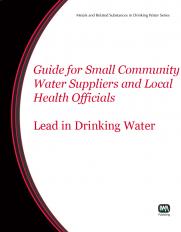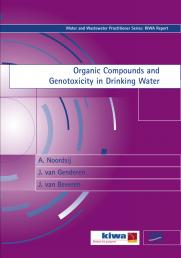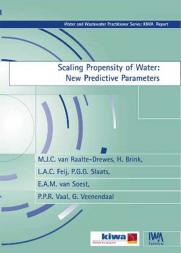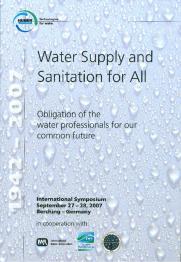 Guide for Small Community Water Suppliers and Local Health Officials on Lead in Drinking Water
Guide for Small Community Water Suppliers and Local Health Officials on Lead in Drinking Water
ISBN: 9781843393801
This Guide for Small Community Water Suppliers and Local Health Officials is one of a series produced by the International Water Association's (IWA) Specialist Group on Metals and Related Substances in Drinking Water. It is an abbreviated compilation of the wide range of scientific, engineering, health and operational issues concerned with the control of lead in drinking water in small water supply systems.
The IWA Specialist Group is supported by members from 26 European countries, Canada and the United States. It is an active research network and has regularly convened international conferences and seminars. It has close working links with the World Health Organization, the European Commission's Joint Research Centre, Health Canada and the US Environmental Protection Agency. The IWA Specialist Group developed out of COST Action 637 (www.cost.esf.org), a European research network. The Guide is supported by a two-day technical training course and a more comprehensive Best Practice Guide on the Control of Lead in Drinking Water (IWA, 2010). Information about training, the Best Practice Guide and the research network in general is available from www.meteau.org. This Guide for Small Community Water Suppliers and Local Health Officials explains why lead in drinking water may still be a threat to public health in small communities. It is aimed at Local Health Officials and the operators of drinking water supply systems that serve small communities. Its objectives are to raise awareness, to provide a basis for assessing the extent of problems, and to identify control options.
 Organic Compounds and Genotoxicity in Drinking Water
Organic Compounds and Genotoxicity in Drinking Water
ISBN: 9781843390480
eISBN: 9781780402598
Until recently only lipophilic compounds were analysed in any research on the occurrence of mutanogenic and carcinogenic compounds in water. They were isolated using XAD-resins. They contain approximately half of the total organic material present in water. A clear mutanogenic effect was demonstrated for these compounds using Amestest. The hydrophilic fraction of the organic material was difficult to investigate because of problems with isolation and analysis caused by its high solubility. The high solubility means in practice that the hydrophilic compounds are mobile in conventional treatment systems and in soil and can easily penetrate into drinking water. A method was developed to isolate hydrophilic compounds using a combination of ion exchange and a clean-up with a XAD-resin. The isolated compounds were examined with the Amestest for the presence of mutanogenic compounds. For some tested water types a mutanogenic effect was found in the lipophilic material. Due to oxidation with ozone, mutanogenic compounds can be formed from (non-mutanogenic) industrial pollutions. No mutanogenic activity was found in the hydrophilic organic material of all examined water types, even after ozone oxidation or chlorination. It was hypothesized that hydrophilic compounds can not reach the DNA of the cell, thus they do not play any (geno) toxicological role.
 Scaling Propensity of Water: New Predictive Parameters
Scaling Propensity of Water: New Predictive Parameters
ISBN: 9781843390473
eISBN: 9781780402567
The commonly used Saturation Index calculated at 10ºC (SI10) is not suitable for practical situations. New parameters have been: TPCC90 (Theoretically Precipitable Calcium Carbonate at 90ºC)developed for simple and rapid analysis of calcium carbonate precipitation (scaling) phenomena which occur during the heating of drinking water; SI90 (Saturation Index at 90ºC); NI (Nucleation Index); PPCC (Practically Precipitable Calcium Carbonate). Both TPCC90 and SI90 describe the hydrodynamic driven force for the scaling reaction. The nucleation index indicates at what rate calcium carbonate precipitation is accelerated by nuclei present in the water. Finally, the PPCC is a measurement under practical conditions, determining the rate of scaling. The suitability of these parameters for predicting scaling was assessed and detailed results are presented in this publication.
 Secondary Settling Tanks: Theory, Modelling, Design and Operation
Secondary Settling Tanks: Theory, Modelling, Design and Operation
ISBN: 9781900222037
Scientific and Technical Reports No. 6
It is hoped that with the publication of this STR, written by consulting and research engineers from different continents and with different backgrounds and experience, the need is met at least in part for a compilation of up-to-date international development in SST design, practice and research over the past two decades. Each chapter ends with research needs that the authors offer as directions for further research and development in this area.
 Water Supply and Sanitation for All
Water Supply and Sanitation for All
ISBN: 9781843395140
eISBN: 9781780409986
The supply of healthy drinking water and disposal of our wastewater is a central problem. Solving this problem is one of the claims of the UN Millennium Development Goals, and consequently an obligation for all those involved with water to join efforts in finding solutions. Climate change, population growth, migration and urban sprawl are factors forcing us to reconsider the traditional approach to urban water management. The water supply and sanitation infrastructure currently in use worldwide was developed in and for countries which are relatively wealthy, and which have access to plenty of water. Is it really wise to build the same kind of infrastructure and to apply the same methods and processes in regions with different climatic, ecological and economical conditions? Should we maintain our flush and discharge sanitation concepts while freshwater is becoming a limited resource? Aren't there smarter more environmentally sound methods to use and safegaurd our precious water resources? Are water authorities, city planners, architects, regulators and politicians ready to accept innovative solutions deviating from those described in textbooks? Questions like these were raised during the International Symposium Water Supply and Sanitation for All held in Berching, Germany from September 27 - 28, 2007. This book collects the papers presented at this conference.